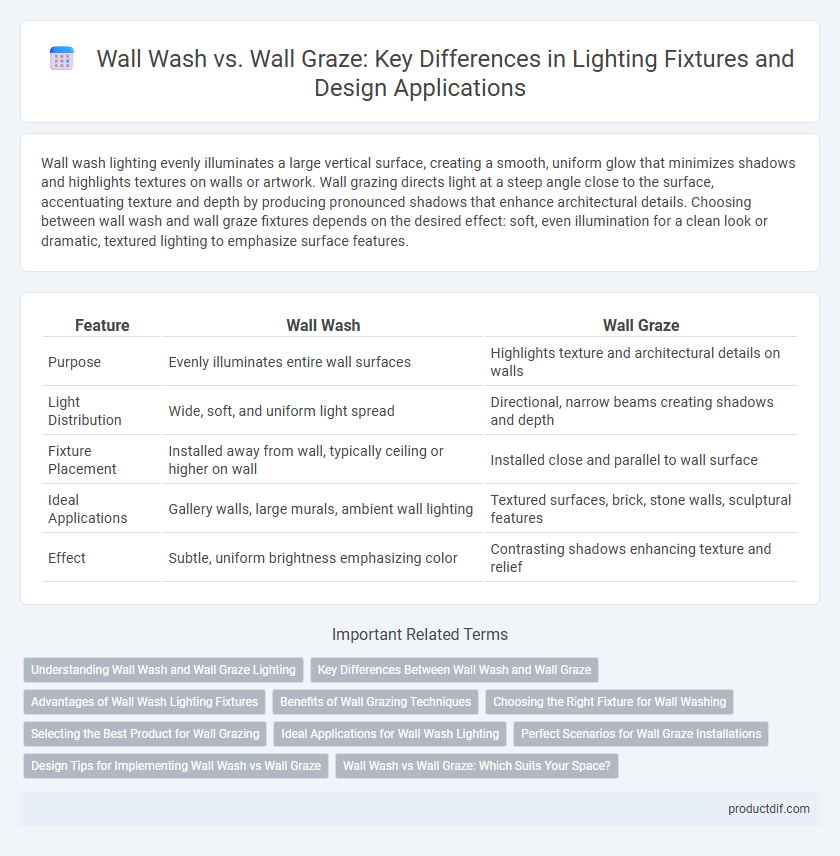Wall wash lighting evenly illuminates a large vertical surface, creating a smooth, uniform glow that minimizes shadows and highlights textures on walls or artwork. Wall grazing directs light at a steep angle close to the surface, accentuating texture and depth by producing pronounced shadows that enhance architectural details. Choosing between wall wash and wall graze fixtures depends on the desired effect: soft, even illumination for a clean look or dramatic, textured lighting to emphasize surface features.
Table of Comparison
| Feature | Wall Wash | Wall Graze |
|---|---|---|
| Purpose | Evenly illuminates entire wall surfaces | Highlights texture and architectural details on walls |
| Light Distribution | Wide, soft, and uniform light spread | Directional, narrow beams creating shadows and depth |
| Fixture Placement | Installed away from wall, typically ceiling or higher on wall | Installed close and parallel to wall surface |
| Ideal Applications | Gallery walls, large murals, ambient wall lighting | Textured surfaces, brick, stone walls, sculptural features |
| Effect | Subtle, uniform brightness emphasizing color | Contrasting shadows enhancing texture and relief |
Understanding Wall Wash and Wall Graze Lighting
Wall wash lighting evenly illuminates an entire wall surface, creating a smooth and uniform light distribution that minimizes shadows and enhances spatial perception. Wall graze lighting, by contrast, emphasizes texture and architectural details by casting light at a sharp angle, producing strong highlights and shadows. Selecting between wall wash and wall graze fixtures depends on the desired visual effect, with wall wash ideal for general ambiance and wall graze suited for accentuating surface textures.
Key Differences Between Wall Wash and Wall Graze
Wall wash lighting provides broad, even illumination that covers large wall surfaces to create a smooth, uniform appearance, ideal for highlighting artwork or architectural elements from a distance. Wall grazing emphasizes texture by casting light at a sharp angle across a surface, accentuating imperfections and details such as brick, stone, or stucco finishes. The key difference lies in wall wash's diffuse coverage designed for ambient effect versus wall graze's focused, dramatic effect that enhances surface textures.
Advantages of Wall Wash Lighting Fixtures
Wall wash lighting fixtures provide uniform illumination that highlights entire wall surfaces, enhancing architectural features and creating a spacious atmosphere. Their broad, soft light minimizes shadows and wall texture imperfections, making them ideal for galleries and commercial spaces requiring consistent brightness. These fixtures improve visual comfort and add depth to interiors by evenly distributing light across vertical planes.
Benefits of Wall Grazing Techniques
Wall grazing creates dramatic textures by emphasizing surface irregularities, enhancing architectural details with sharp shadow definition. This technique improves spatial perception and depth by casting angled light that accentuates wall textures. Wall grazing also increases visual interest and ambiance, making it ideal for highlighting brick, stone, or textured wall finishes.
Choosing the Right Fixture for Wall Washing
Wall wash fixtures evenly distribute light across a vertical surface, highlighting architectural features with soft, shadow-free illumination ideal for general ambiance. In contrast, wall graze fixtures emphasize texture by casting light at a sharp angle, creating shadows that accentuate surface details such as brick or stone. Selecting the right fixture depends on the desired effect: choose wall wash for uniform brightness and wall graze to enhance texture and depth in wall design.
Selecting the Best Product for Wall Grazing
Wall grazing requires selecting lighting fixtures with narrow beam angles and high lumen output to enhance texture and architectural details on vertical surfaces. Opt for fixtures designed with adjustable heads and precise beam control for effective wall grazing applications. Prioritize LED wall grazers with high CRI (Color Rendering Index) to ensure accurate color representation and energy efficiency.
Ideal Applications for Wall Wash Lighting
Wall wash lighting is ideal for evenly illuminating large vertical surfaces, making it perfect for art galleries, retail displays, and architectural features where uniform light coverage enhances visibility. This technique minimizes shadows and surface texture, emphasizing color and detail on walls. It is most effective when mounted at a distance from the wall to create a smooth, continuous wash of light.
Perfect Scenarios for Wall Graze Installations
Wall graze lighting fixtures are ideal for highlighting textured or uneven wall surfaces, such as brick, stone, or concrete, by casting shadows that emphasize depth and detail. These installations work best in architectural spaces where creating dramatic wall effects enhances visual interest, like galleries, feature walls, or retail displays. Optimal placement involves positioning the fixtures close to the wall to maximize shadow definition and surface texture.
Design Tips for Implementing Wall Wash vs Wall Graze
Wall Wash lighting evenly illuminates entire surfaces, making walls appear smooth and uniform, ideal for highlighting artwork or architectural features with minimal shadow. Wall Graze emphasizes texture by casting light at a steep angle, enhancing surface details and creating dramatic shadow effects perfect for brick, stone, or textured walls. To optimize design, position Wall Wash fixtures farther from the wall to achieve uniform light, while Wall Graze fixtures should be installed closer and at a sharp angle to accentuate texture and depth.
Wall Wash vs Wall Graze: Which Suits Your Space?
Wall Wash lighting evenly illuminates large vertical surfaces, creating a smooth, uniform glow ideal for highlighting artwork or textured walls, while Wall Graze emphasizes surface texture by casting light at a steep angle, enhancing architectural details with shadows and depth. Choosing between Wall Wash and Wall Graze depends on the desired ambiance and surface characteristics in your space, with Wall Wash suited for broad, flat walls and Wall Graze perfect for textured or uneven surfaces. Consider fixture placement, beam angle, and wall finish to optimize lighting effects and enhance interior design.
Wall Wash vs Wall Graze Infographic

 productdif.com
productdif.com